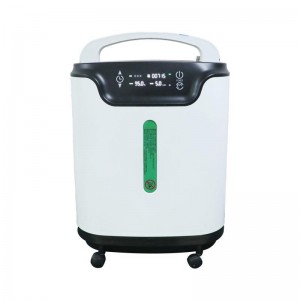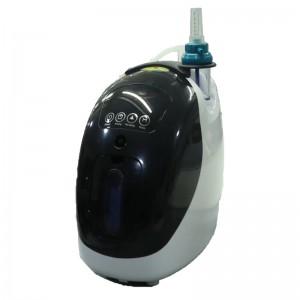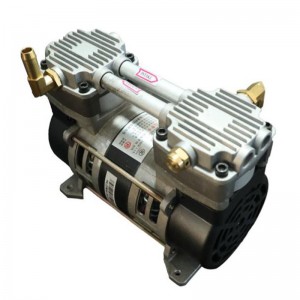Small Oxygen Generator WY-301W
|
Model |
Product profile |
|
WY-301W
|
①、Product technical indicators |
| 1、Power Supply:220V-50Hz | |
| 2、Rated power:430VA | |
| 3、noise:≤60dB(A) | |
| 4、Flow range:1-3L/min | |
| 5、oxygen concentration:≥90% | |
| 6、Overall dimension:351×210×500mm | |
| 7、weight:15KG | |
| ②、 Product features | |
| 1、Imported original molecular sieve | |
| 2、Imported computer control chip | |
| 3、The shell is made of engineering plastic ABS | |
| ③、 Restrictions for transportation and storage environment | |
| 1、Ambient temperature range:-20℃-+55℃ | |
| 2、Relative humidity range:10%-93%(no condensation) | |
| 3、Atmospheric pressure range:700hpa-1060hpa | |
| ④、 Others | |
| 1、Attachments: one disposable nasal oxygen tube, and one disposable atomization component | |
| 2、The safe service life is 5 years. See the instructions for other contents | |
| 3、The pictures are for reference only and subject to the real object. |
Main technical parameters of the product
|
No. |
model |
Rated voltage |
rated power |
rated current |
oxygen concentration |
noise |
Oxygen flow Range |
work |
Product size (mm) |
Atomization function(W) |
Remote control function(WF) |
weight(KG) |
|
1 |
WY-301W |
AC 220V/50Hz |
260W |
1.2A |
≥90% |
≤60 dB |
1-3L |
continuity |
351×210×500 |
Yes |
- |
15 |
|
2 |
WY-301WF |
AC 220V/50Hz |
260W |
1.2A |
≥90% |
≤60 dB |
1-3L |
continuity |
351×210×500 |
Yes |
Yes |
15 |
|
3 |
WY-301 |
AC 220V/50Hz |
260W |
1.2A |
≥90% |
≤60 dB |
1-3L |
continuity |
351×210×500 |
- |
- |
15 |
WY-301W small oxygen generator (small molecular sieve oxygen generator)
1、Digital display, intelligent control, simple operation;
2、One machine for two purposes, oxygen generation and atomization can be switched at any time;
3、Pure copper oil-free compressor with longer service life;
4、Universal wheel design, easy to move;
5、Imported molecular sieve, and multiple filtration, for more pure oxygen;
6、The intelligent portable design can be easily used by the elderly and pregnant women.
Product Appearance Dimensions drawing: (Length: 351mm × Width: 210mm × Height: 500mm)

working principle:
Working principle of small oxygen generator: use molecular sieve physical adsorption and desorption technology. The oxygen concentrator is filled with molecular sieves, which can absorb nitrogen in the air when pressurized, and the remaining unabsorbed oxygen is collected and purified to become high-purity oxygen. The molecular sieve discharges the adsorbed nitrogen back into the ambient air during decompression, and can absorb nitrogen and produce oxygen during the next pressurization. The whole process is a periodic dynamic cycle process, and the molecular sieve does not consume.
About oxygen inhalation knowledge:
With the continuous improvement and improvement of people’s living standards, the demand for health is gradually increasing, and oxygen inhalation will gradually become an important means of family and community rehabilitation. However, many patients and oxygen users do not know enough about oxygen inhalation knowledge, and oxygen therapy is not standardized. Therefore, who needs oxygen inhalation and how to inhale oxygen are the knowledge that every patient and oxygen user must understand.
Hypoxic hazards:
The harm and important manifestations of hypoxia to the human body Under normal circumstances, the main hazards of hypoxia to the human body are as follows: when hypoxia occurs, the aerobic metabolic rate in the human body decreases, anaerobic glycolysis is strengthened, and the metabolic efficiency of the body decreases; long-term severe hypoxia can cause Pulmonary vasoconstriction causes pulmonary hypertension and increases the burden on the right ventricle, which can lead to cor pulmonale in the long run; hypoxia can aggravate high blood pressure, increase the burden on the left heart, and even cause arrhythmia; hypoxia stimulates the kidney to produce erythropoietin, which makes the body Increased red blood cells, high blood viscosity, increased peripheral vascular resistance, increased burden on the heart, causing or aggravating heart failure, and easily inducing cerebral thrombosis; long-term brain hypoxia can produce a series of mental and neurological symptoms: such as sleep disorders, mental decline, Memory loss, abnormal behavior, personality changes, etc. Usually, people have the following important manifestations of hypoxia: increased frequency of breathing, dyspnea, chest tightness, shortness of breath, cyanosis of lips and nail beds; rapid heartbeat; due to enhanced anaerobic glycolysis, increased lactic acid levels in the body, often fatigue, fatigue Inattention, decreased judgment and memory; Nocturnal sleep disturbance, decreased sleep quality, drowsiness during the day, dizziness, headache and other symptoms.











